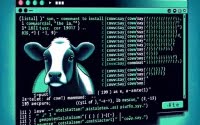[SOLVED]: Docker Invalid Reference Format | Causes and Solutions
Have you ever encountered the ‘Docker Invalid Reference Format’ error message, leaving you puzzled and frustrated? If so, you’ve landed on the right page.
This blog post will guide you through the common triggers of this Docker error and, more importantly, how to rectify it.
We aim to help you comprehend the Docker Invalid Reference Format error, its causes, and provide in-depth solutions to get you back on track. Let’s dive in!
TL;DR: What is Docker Invalid Reference Format Error
The Docker Invalid Reference Format error generally occurs when Docker fails to correctly interpret the syntax of your Docker image name. The image name plays a crucial role as Docker uses it to locate and pull the appropriate image from the Docker registry. If this name is not formatted correctly, Docker responds with an ‘invalid reference format’ error.
Example of an image name with incorrectly encoded hyphen:
docker pull my–image
In the command above, ‘my–image’ is not a valid image name because it contains an incorrectly encoded hyphen.
Example of an image name not adhering to standard DNS rules:
docker pull my_Image
In the command above, ‘my_Image’ is not a valid image name because it contains an uppercase letter.
Table of Contents
Understanding Docker Invalid Reference Format Error
It’s important to distinguish this error from Docker’s inability to locate your image in the registry. The latter usually occurs when the image doesn’t exist in the registry, or an incorrect image name has been provided.
However, the ‘invalid reference format’ error specifically points to a syntax issue in the image name.
Example of an incorrectly formatted Docker image name:
docker pull Ubuntu:Latest
In the command above, ‘Ubuntu:Latest’ is not a valid image name because it contains uppercase letters.
Several common triggers can lead to this error. These include not adhering to standard DNS naming rules, using uppercase letters, and incorporating special characters in the image name.
Docker follows a specific process to parse image names, and if it encounters an unfamiliar character or string, it returns this error.
Common Causes of Docker Invalid Reference Format Error
Grasping Docker’s naming conventions is key to avoiding such errors. Docker image names must be valid ASCII and must comply with standard DNS naming rules. This requires them to be lowercase and consist only of numbers, hyphens, periods, and underscores.
| Rule | Description | Good Example | Bad Example |
|---|---|---|---|
| Lowercase | Image names must be in lowercase. | my_docker_image | My_Docker_Image |
| Valid ASCII | Image names must consist of valid ASCII characters. | docker_image_1 | docker_image_€ |
| Numbers | Image names can include numbers (0-9). | image007 | |
| Hyphens | Hyphens cannot begin or end a DNS label in Docker image names, which is sectioned off by periods or slashes. | docker-image | -docker-image or docker-image- |
| Periods | Periods cannot start or end an image name or be used consecutively. They are used to separate DNS labels. | docker.image | .dockerimage or dockerimage. or docker..image |
| Underscores | Underscores are acceptable characters in Docker image names. | docker_image | |
| DNS Naming Conventions | Docker image names must obey standard DNS naming rules which restrict labels to start or end with hyphens, and must be between 1-63 characters long. | my.dockerimage1 | -my.dockerimage1 or my.dockerimage1- |
| Length | Total length of the image name, including slashes, must not be more than 255 characters. | dockerimage | a_very_long_docker_image_exceeding_255_characters |
By sticking to these conventions, you can avert the Docker Invalid Reference Format error and ensure the smooth operation of your Docker containers.
Standard DNS Rules: The Essential Guide
The Docker Invalid Reference Format error often arises when standard DNS rules are overlooked while naming Docker images. Docker image names need to be valid ASCII and should comply with DNS naming conventions.
They should be in lowercase and consist only of numbers, hyphens, periods, and underscores. If your image name fails to meet these criteria, Docker throws an ‘invalid reference format’ error.
The Impact of Uppercase Letters
Using uppercase letters in your Docker image name can also trip the ‘invalid reference format’ error. Docker image names are case-sensitive and must be in lowercase. If uppercase letters are used, Docker fails to recognize the image name, resulting in an error.
Example of an image name with uppercase letters:
docker pull MyImage
In the command above, ‘MyImage’ is not a valid image name because it contains uppercase letters.
Special Characters: Use with Caution
The inclusion of special characters in your Docker image name can lead to the ‘invalid reference format’ error. Docker only recognizes numbers, hyphens, periods, and underscores in image names.
The use of any other special characters can lead to Docker failing to parse the image name and throwing an error.
Example of an image name with special characters:
docker pull my@image
In the command above, ‘my@image’ is not a valid image name because it contains a special character ‘@’.
The Copy-Pasting Conundrum: Encoding Mishaps
Encoding mishaps during the copy-pasting process, especially with hyphens, is another common cause of this error. If a hyphen is encoded incorrectly during copy-pasting, Docker may fail to recognize it, resulting in an ‘invalid reference format’ error.
Docker naming conventions use separators like hyphens, periods, and underscores to differentiate between different parts of the image name. If these separators are encoded incorrectly, Docker may fail to correctly parse the image name, leading to the ‘invalid reference format’ error.
Operating System: A Potential Pitfall
The operating system you’re using can also influence the occurrence of this error. Some operating systems may have different default encoding settings, which can lead to errors when copy-pasting Docker commands or image names.
It’s always advisable to double-check your Docker commands and image names for any potential encoding issues before running them.
Solutions to Docker Invalid Reference Format Error
Having understood the common causes of the Docker Invalid Reference Format error, let’s explore some practical solutions to resolve it.
Lowercase Characters: A Simple Solution
As previously discussed, Docker image names are case-sensitive and must be in lowercase. If you’ve used uppercase letters in your Docker image name, rectifying the error is as simple as changing them to lowercase. For instance, if your Docker image name is ‘MyImage’, alter it to ‘myimage’.
Splitting Long Docker Commands: A Word of Caution
Working with long Docker commands often necessitates splitting them across multiple lines for better readability. However, if not executed correctly, this can trigger the ‘invalid reference format’ error. When splitting Docker commands, make sure that each command and its corresponding arguments are on the same line. For instance:
docker run -d -p 8080:80 --name mycontainer \
myimage
In the command above, the ‘\’ at the end of the line signals Docker that the command continues on the next line.
Using ${Pwd} and $(Pwd) Path: Beware of Potential Errors
When using the ${Pwd} or $(Pwd) path in your Docker commands, bear in mind that these paths can sometimes trigger the ‘invalid reference format’ error. This happens because these paths are expanded by the shell before Docker parses the command.
If the expanded path contains any characters that Docker doesn’t recognize, it will throw an error. To prevent this, always check the expanded path for any potential issues before executing the command.
Manual Correction of Hyphens, Slashes, and Colons
As highlighted earlier, encoding mishaps with hyphens, slashes, and colons can cause the ‘invalid reference format’ error. Different characters can sometimes look identical! Therefore the name may look valid, but actually contains special characters.
If you suspect this to be the case, try manually correcting these characters in your Docker command or image name. For instance, if you’ve copied a Docker command from a website or document, consider deleting and manually typing the hyphens, slashes, and colons to ensure they’re correctly encoded.
MultiLine commands
In addition to these solutions, knowing how to write multiline Docker commands without triggering the reference format error can be highly beneficial. This involves correctly using the ‘\’ character to indicate that the command continues on the next line, and ensuring that each command and its arguments are on the same line.
Shell Compatibility
Lastly, it’s worth noting that the shell you’re using can influence the way you write Docker commands. Different shells may interpret and expand variables and paths in Docker commands differently, potentially leading to the ‘invalid reference format’ error. Understanding the nuances of your shell, and how it interacts with Docker, can help you avoid this error.
Docker Commands and Variables: A Closer Look
Gaining a deeper understanding of Docker commands and variables can be instrumental in preventing the ‘invalid reference format’ error. Docker commands often incorporate variables, such as $VERSION, within the image name. If these variables are not correctly set or unset, Docker may return an ‘invalid reference format’ error.
For instance, let’s examine the following Docker command:
docker pull ubuntu:$VERSION
In this command, $VERSION is a variable that represents the version of the Ubuntu image you intend to pull. If $VERSION is not set, Docker will attempt to pull an image named ‘ubuntu:’, which is not a valid image name and will result in an ‘invalid reference format’ error.
To circumvent this, ensure that all variables in your Docker commands are correctly set. For instance, you could set $VERSION to ‘latest’ to pull the latest version of the Ubuntu image, or to ‘18.04’ to pull a specific version.
VERSION=latest
docker pull ubuntu:$VERSION
In the command above, $VERSION is set to ‘latest’, meaning Docker will pull the latest version of the Ubuntu image.
Arguments Lead to Fights
Another common pitfall is that Docker commands can misinterpret arguments as the image name if the order of command line arguments is incorrect. For example, consider the following command:
docker run ubuntu:latest -d -p 8080:80 --name mycontainer
In this command, Docker will attempt to run an image named ubuntu:latest -d -p 8080:80 --name mycontainer, which is not a valid image name and will result in an ‘invalid reference format’ error.
The correct order of arguments should be:
docker run -d -p 8080:80 --name mycontainer ubuntu:latest
By paying meticulous attention to the syntax and order of arguments in your Docker commands, and ensuring that all variables are correctly set, you can significantly reduce the likelihood of encountering the ‘invalid reference format’ error, ensuring the smooth operation of your Docker containers.
Recap and Conclusion
Let’s quickly revisit what we’ve covered in this comprehensive guide. We’ve delved into the Docker Invalid Reference Format error, its common causes, and provided in-depth solutions to resolve it. We’ve also emphasized the importance of understanding Docker’s naming conventions and how they play a pivotal role in preventing such errors.
We’ve also explored Docker commands and variables, and how they can influence the occurrence of this error. By paying careful attention to the syntax and order of arguments in your Docker commands, and ensuring that all variables are correctly set, you can significantly reduce the likelihood of encountering this error.
In the long haul, understanding and resolving Docker errors like the Docker Invalid Reference Format error can enhance your proficiency with Docker, improve your problem-solving skills, and make you a more effective developer or system administrator. So, the next time you encounter this error, don’t view it as a roadblock, but as an opportunity to learn and grow.
Remember, the key to mastering Docker is understanding its nuances, including its errors. So, keep learning and keep growing!


